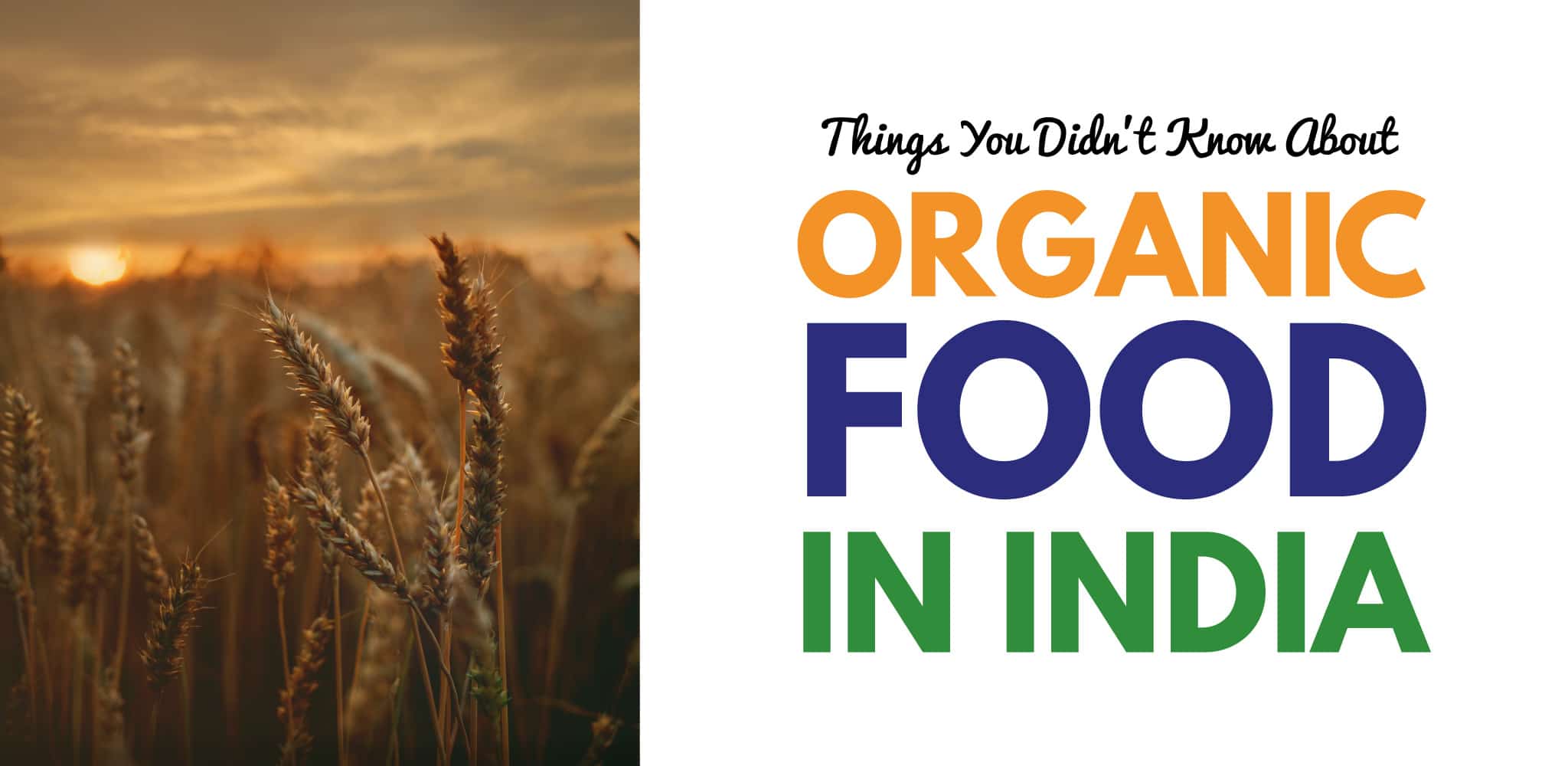The popularity of organic food in India has steadily been rising, with many people opting to consume them to reduce their exposure to pesticides or in an effort to be more environment friendly or both. However, most people don’t know much about the regulations behind organic food in India and what the various logos and certifications mean. So I thought of writing this small post to not only educate you about these topics but also to provide you with links to a variety of official sources from the government of India where you can read more about them.
What is organic food?
According to the Food Safety and Standards Authority of India (FSSAI) –
“Organic foods are the products of holistic agricultural practices focusing on biodiversity, soil health, chemical free inputs etc. with an environmentally and socially responsible approach and are produced in accordance with organic production standards.”
According to the Food and Agriculture Organization (FAO) of the United Nations –
“Organic agriculture takes a proactive approach as opposed to treating problems after they emerge.”
In other words, these crops are produced using agricultural practices that are environment friendly.
The idea of getting good nutrition while being environment-friendly sounds like a win-win for everyone. And according to the FAO, it is in fact better than conventional farming for environmental sustainability, soil and groundwater health, climate change, and biodiversity. A 2019 study also found that consuming a higher amount of organic food was associated with greater environmental benefits.
The Regulation of Organic Food in India
The production of organic food in India is regulated by 2 bodies –
- The Participatory Guarantee System (PGS) implemented by the Ministry of Agriculture and Farmers Welfare.
- National Programme for Organic Production (NPOP) implemented by the Ministry of Commerce and Industry.
Both, the PGS and the NPOP have laid down certain guidelines for the producers of organic foods that need to be followed to be able to certify their foods as organic. As an example, here are the requirements laid down by the PGS –
Single Ingredient Products
Single ingredient products may be certified as “PGS-India Organic” when all standard requirements have been met. These ‘standard requirements’ have been defined in great detail over here if you wish to read more about them. For example, the use of GMOs or their products, directly or indirectly are strictly prohibited.
Multi Ingredient Products
If 100% of all ingredients are of PGS-India organic origin, products may be labelled as “Organic” when all standard requirements have been met in respect of all ingredients.
If at least 95% of the ingredients are organic, including allowed additives, processing aids and preservatives, products may be certified as organic. Therefore, it’s not necessary for all the ingredients in a multi-ingredient product to be of organic origin for the product to certified as organic.
If 70 to 95% of the ingredients are organic, products may not be called organic and can only be certified as “made with organic ingredients”.
Products from fields under conversion
For a farm and its products to be certified organic, it is mandatory for the farm and all its production units to undergo a period of organic conversion. This conversion period may last anywhere between 24 to 36 months. Organic products obtained from the agricultural fields which are under the process of organic conversion are to be certified as PGS-India Green and not PGS-India Organic (which is reserved only for organic products obtained from fully converted fields).
Logos
Indian Logos
Organic food in India also carry a variety of logos to help you distinguish them from non-organic products. Organic foods of large businesses carry the FSSAI’s ‘Jaivik Bharat’ logo and either the PGS or NPOP’s logo as seen below. Under the PGS system, organic products from fields under conversion shall carry the ‘PGS-India Green’ logo.

P.S. – Small original producers or producer organizations, defined as those whose annual turnover does not exceed Rs.12 lakhs per annum, are exempted from the need of any of the above-mentioned verifications or their logos.
So don’t expect every organic food company you see at the store to have these logos. If you doubt their authenticity, you should get in touch with the company and ask them to provide you with more information about their agricultural practices.
Other Logos
I have observed that some organic products in India also contain a few more logos in apart from the Indian logos shown above. These include the EU (European Union) and the USDA (United States Department of Agriculture) logos as shown below.
 While the Indian logos are mandatory for the organic companies to operate in India, the EU and USDA logos aren’t. So why even bother of going through the hassle of getting them in the first place?
While the Indian logos are mandatory for the organic companies to operate in India, the EU and USDA logos aren’t. So why even bother of going through the hassle of getting them in the first place?
The reason why some Indian companies acquire these logos for their products is to be able to export their products into the countries belonging to the EU and the United States of America. As in the case of Indian logos, the companies need to satisfy many requirements before they become eligible to use these logos on their products. While their requirements are similar to the ones laid down by the Indian logos, we have highlighted the most important ones for you to understand the significance of the logos.
EU Logo
This logo is required in the EU for pre-packaged food products, produced and sold as organic within the EU. To use the logo, at least 95% of the ingredients of the food product must be of organic origin. Organic products from fields under conversion cannot use this logo.
The logo can also be used by organic products that are –
- Imported into the EU which meet it’s standards of organic food.
- Exported out of the EU and sold in other countries.
Some Indian organic products contain the EU logo as this allows them to sell their products in countries belonging to the EU. There are also specific guidelines for Indian organic products that wish to use the EU logo to be exported into the EU. These can be found here.
Indian products using this logo will state ‘Non-EU Agriculture’ to indicate that at least 98% of the organic product has originated in India.

On the other hand, organic products imported from the EU (i.e., originating in the EU) into India will state ‘EU Agriculture’ to indicate that at least 98% of the organic product has originated in the EU. The EU/Non-EU agriculture tags under the EU logo on an organic product in India will help you understand if the product is of Indian origin or not.
If you are interested in knowing the exact requirements that need to be met to be able to use this logo, they can be found in 2 documents that have been issued by the European Commission – EC 834/2007 and EC 889/2008.
USDA Organic
The National Organic Program (NOP) of the United States of America develops the rules & regulations for the production, handling, labeling, and enforcement of all USDA (United States Department of Agriculture) organic products.
There are 4 different organic labels out of which 2 are eligible to use the USDA Organic logo while the other 2 are not –
- Products eligible to use the USDA Organic logo –
- 100 Percent Organic
- A product that contains 100 percent organic ingredients (excluding salt and water).
- Most raw, unprocessed or minimally processed farm crops.
- Organic
- Any product where at least 95% of the ingredients are organic (excluding salt and water).
- 100 Percent Organic
- Products not eligible to use the USDA Organic logo –
- Made with Organic
- If 70 – 95% of the ingredients in a product are organic (excluding salt and water), then these products can only write ‘Made With Organic’.
- However, the non-organic ingredients also have to meet some stringent criteria.
- Specific Organic Ingredients Listing
- If less than 70% of the ingredients in a product are organic, then only the ingredients which are organic may be listed in the ingredient list as organic but not the entire product.
- The percentage of organic ingredients also needs to be mentioned.
- The non-organic ingredients are not required to follow the USDA organic regulations.
- Products from Fields Under Conversion
- Ingredients produced from fields under conversion also cannot use the USDA Organic logo.
- Made with Organic
More information about the USDA’s rules for labeling organic products can be found here.
Is organic food in India free of insecticides?
Many people think that organic food in India is completely free of insecticides. While the use of synthetic insecticides is strictly prohibited in the lifecycle of organic foods in India, the presence of very small amounts of residual insecticide is still permissible in the final product.
According to the FSSAI –
“Limits shall be 5% of the maximum limits prescribed or Level of Quantification (LoQ) whichever is higher for foods specified under the Food Safety and Standards (Contaminants, Toxins and Residues) Regulations, 2011.”
You can see these limits for yourself by clicking here. The final amount of insecticide residue that you get with the mentioned limits will be very small, but this still might be a deal breaker for some people. You may visit the links mentioned above to check out the exact limits of all the insecticides.
I hope that this article has helped you learn more about organic foods and the regulations of organic foods in India. Let me know your thoughts or questions in the comments!
If you liked this article, be sure to check out our other articles over here.





2 Responses
Thank you for sharing such well researched and informed information on organic food in India. A topic that I was most curious about but didn’t quite find satisfactory answers anywhere. This will certainly help in making informed purchases versus advertisement driven ones. Thanks again!
I am happy to hear that this article has helped you!
Comments are closed.